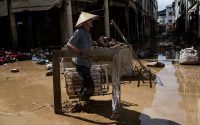Friday Briefing: Narendra Modi’s India
Modi’s choices
Narendra Modi has just won re-election as India’s prime minister, though by a far narrower margin than expected. With his third consecutive term, the charismatic strongman has sealed his position as the country’s most significant leader in generations.
Despite having led India for a decade, Modi has in some ways kept his country guessing about his vision. On major issues — India’s relationships, its economy, its society and its government — it’s still unclear what sort of country Modi wants India to be.
In today’s newsletter, I’ll explain four of the big questions.
Where will India find friends?
India has spent recent years deepening its relationship with the U.S. It has gotten closer to American allies, including Japan and Australia, and ordered high-end American weapons systems — the kind that create dependence down the road. And it is unlikely to side with China. In 2020, Chinese troops crossed into territory controlled by India and killed 20 soldiers in a skirmish. Modi has kept Beijing at arm’s length since then.
But Modi, 73, has signaled that he doesn’t want to be a U.S. ally. Some officials in his inner circle still regard the U.S. warily. American diplomats complain about New Delhi’s apparent efforts to erode democratic norms and the rights of minority groups. So India keeps its options open. After Russia invaded Ukraine, the U.S. tried in vain to persuade India to take a stand against the war. India still processes Russian oil (picking up the slack created by international sanctions). It still buys weapons from Russia.
India spent the Cold War trying to position itself as a nonaligned power. Old habits die hard.
What type of economy?
India recently overtook China as the most populous country and the fastest-growing large economy. Still, most of the country remains poor. Some 800 million people need help filling their stomachs. Modi’s ideas about how to help them can be contradictory, at once globally minded and protectionist.
One path would be to follow East Asian countries, which escaped poverty by manufacturing goods for export. To that end, Modi began a “Make in India” initiative in 2014, an effort to replace China as the world’s factory. But exports have barely risen, even as Modi has thrown new subsidies at them. Some Indian economists say it’s better to focus on exporting services, like I.T. and remote professional work.
Another Modi vision is for a “self-reliant India,” which would reduce the country’s exposure to global supply chains. Shielding Indian companies from foreign competition is at odds with preparing them for it.
In the face of big economic decisions, Modi sometimes seems equivocal. Like Reagan and Thatcher, he came to power promising to pare down government. In practice, the state wields a heavy hand in most sectors — imposing radical, sometimes half-baked reforms by decree.
Protecting minority groups?
India’s founders crafted a constitution for a diverse and secular republic. Modi has been reshaping the country as an explicitly Hindu nation. He converted Jammu and Kashmir, the country’s only Muslim-majority state, into a heavily policed federal territory. He built a giant Hindu temple on a disputed site where mobs had torn down a mosque. During the campaign this year, he called Muslims, who make up 14 percent of the population, “infiltrators.” India’s Muslims say they have been turned into second-class citizens.
Modi’s third term will be a test: Has the Hindu nationalist project been fulfilled, or is there more he can do to assert one faith’s supremacy? The call to put Muslims in their place is the lifeblood of Modi’s party, creating winning majorities within a hugely diverse and caste-riven Hindu population. In a third term, Modi could choose new targets, perhaps by agitating for the replacement of historic mosques with more Hindu temples. He may be constrained, however, by his new political partners, who are not beholden to his party’s Hindu-first projects.
How much authoritarianism?
One reason for Modi’s enduring popularity is that he’s effective. Modi often imposes reforms suddenly, relying on boldness and even the element of surprise to cut through red tape. He streamlined the tax system and even started a semiconductor industry from scratch. He has no patience for obstacles of any kind.
One result is that the world’s biggest democracy has set aside many democratic norms. The police have thrown leaders of the opposition in jail, swelling the number of political prisoners. The Election Commission has been stacked with pro-Modi appointees. The judiciary hardly ever stands in the way of government priorities.
Modi seems to have kept his job but lost his parliamentary majority. Now he’ll need to placate coalition partners and consult them on major changes. Maybe that will protect some of the institutions that were built to preserve fair play.
The other possibility is that Modi will crack down harder than ever, making full use of the agencies that answer directly to him, to ensure that his party stays ahead of the invigorated competition. Modi has made it this far despite all the complaints about repression. If anything is to hold him back now, it will have to come from within his new governing coalition.
For more:
MORE TOP NEWS
Israel-Hamas War
China is easing restrictions on home buying, to try to get more people to purchase apartments. But a vocal group of existing homeowners is angry. They pinched and saved to buy their apartments, and now they’re worried that the effort could depress prices.
CONVERSATION STARTERS
-
Mitsuko Uchida: The star pianist spoke to my colleague Javier Hernández. She was both confrontational and scholarly. Read their conversation here.
-
Subterranean refuges: Wombat burrows can serve as fireproof shelters for small mammals, birds and reptiles during and after extreme fires.
-
Eat up: How healthy are avocados?
Take our friendship challenge
Friendship is healing. It helps improve long-term physical and mental health, and can enhance daily well-being. But our social circles may be shrinking. People across the world are in the middle of a well-documented loneliness crisis.
So my colleagues on the Well desk worked with researchers and therapists to create a five-day challenge, which starts next week, to help readers revive wilted relationships, feel more connected to friends and have the tools to keep bonds strong. Sign up here.


